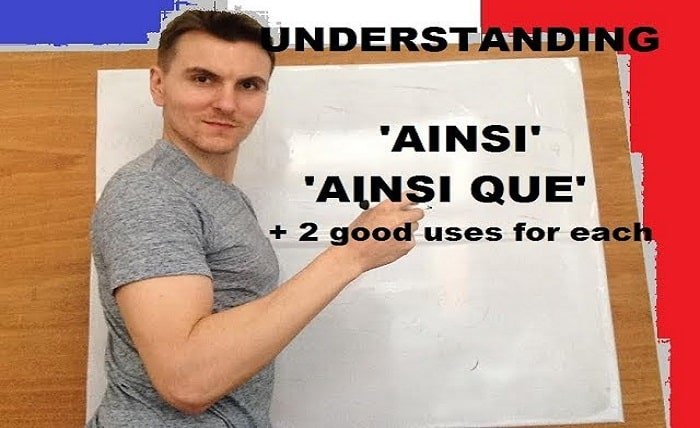
Introduction
The French phrase “ainsi que” is a versatile and essential component of the language, often used to link ideas and add depth to sentences. Understanding how to use “ainsi que” correctly can significantly improve your fluency in French. This comprehensive guide delves into its meanings, applications, and nuances, providing practical tips and examples to master “ainsi que.”
The Meaning of “Ainsi Que”
“Ainsi que” translates to “as well as” or “just as” in English. It is used to connect similar ideas or elements within a sentence, emphasizing the inclusion of multiple items or actions. For instance, “Il aime les pommes ainsi que les oranges” means “He likes apples as well as oranges.”
Historical Context of “Ainsi Que”
The usage of “ainsi que” has evolved over centuries, maintaining its role as a connector in the French language. Historical texts and literature often employed “ainsi que” to link complex ideas and elaborate on themes. Understanding its historical context enhances our appreciation of its current usage.
“Ainsi Que” in Modern French
In contemporary French, “ainsi que” is commonly used in both spoken and written language. It helps in creating fluid and coherent sentences by linking similar concepts or actions. Recognizing its prevalence in modern French is crucial for effective communication.
Grammar Rules for Using “Ainsi Que”
“Ainsi que” is typically used to join nouns, pronouns, or verbs within a sentence. For example, “Elle chante ainsi que danse” (She sings as well as dances). Understanding these grammatical structures helps in constructing accurate and meaningful sentences with “ainsi que.”
Differences Between “Ainsi Que” and Similar Phrases
While “ainsi que” is similar to phrases like “et” (and) and “ainsi” (thus), it has a distinct function. “Et” simply adds another element, while “ainsi que” emphasizes equality between the linked elements. For instance, “Il est intelligent et diligent” (He is intelligent and diligent) versus “Il est intelligent ainsi que diligent” (He is intelligent as well as diligent).
Practical Examples of “Ainsi Que”
Practical examples illustrate the usage of “ainsi que” effectively. Consider sentences like “Il parle anglais ainsi que français” (He speaks English as well as French) and “Elle est connue pour sa gentillesse ainsi que son intelligence” (She is known for her kindness as well as her intelligence). These examples show how “ainsi que” integrates into everyday language.
“Ainsi Que” in Formal Writing
In formal writing, such as academic papers, business reports, and official documents, “ainsi que” is often used to articulate complex ideas clearly. For instance, “L’entreprise vise à améliorer ses produits ainsi que ses services” (The company aims to improve its products as well as its services). Mastering “ainsi que” enhances the clarity and professionalism of formal writing.
“Ainsi Que” in Conversational French
“Ainsi que” is also useful in conversational French to link similar actions or items, adding fluency to speech. For example, “Je vais acheter du pain ainsi que du lait” (I’m going to buy bread as well as milk). Using “ainsi que” in conversations makes your French sound more natural and coherent.
Teaching “Ainsi Que” to French Learners
For educators, teaching “ainsi que” involves providing clear definitions, examples, and exercises. Role-playing and writing activities can help learners practice using “ainsi que” in various contexts, reinforcing their understanding and application of the phrase.
Common Mistakes with “Ainsi Que”
Learners often confuse “ainsi que” with similar conjunctions or misuse it in sentence construction. A common mistake is using it where “et” should be used. For example, “Il aime nager ainsi que courir” (He likes swimming as well as running) is correct, while “Il aime nager et courir” (He likes swimming and running) is simpler but correct. Highlighting and correcting such errors is essential for mastering “ainsi que.”
Benefits of Mastering “Ainsi Que”
Mastering “ainsi que” enriches your French language skills, allowing for more precise and varied expressions. It enables you to construct complex sentences that clearly convey inclusivity and equality between elements, enhancing both your spoken and written French. Proficiency in using “ainsi que” also adds to your overall fluency and comprehension.
The Future of “Ainsi Que” Usage
The future of “ainsi que” usage remains strong, with its consistent application in both formal and informal French. As the language evolves, “ainsi que” continues to be a reliable connector of ideas, essential for clear and effective communication. Staying updated with its usage trends ensures your French remains current and sophisticated.
Conclusion
“Ainsi que” is a versatile and essential phrase in the French language, crucial for linking similar ideas or actions. By understanding its meaning, grammatical rules, and applications, learners can enhance their French language skills significantly. Whether in formal writing or casual conversation, mastering “ainsi que” allows for clearer and more sophisticated communication. Embrace the nuances of “ainsi que” to elevate your proficiency in French.
FAQs
Q1: What does “ainsi que” mean in French?
A1: “Ainsi que” means “as well as” or “just as” in English, used to link similar ideas or elements within a sentence.
Q2: How is “ainsi que” used in a sentence?
A2: “Ainsi que” is used to join nouns, pronouns, or verbs, emphasizing equality. For example, “Il cuisine ainsi que jardine” (He cooks as well as gardens).
Q3: What is the difference between “ainsi que” and “et”?
A3: “Ainsi que” emphasizes equality between linked elements, while “et” simply adds another element. “Ainsi que” is more formal and nuanced.
Q4: Can “ainsi que” be used in conversational French?
A4: Yes, “ainsi que” is useful in conversational French to add fluency and coherence, linking similar actions or items naturally.
Q5: What are common mistakes when using “ainsi que”?
A5: Common mistakes include confusing “ainsi que” with “et” and misusing it in sentence construction. Correct usage is crucial for proper sentence structure.



